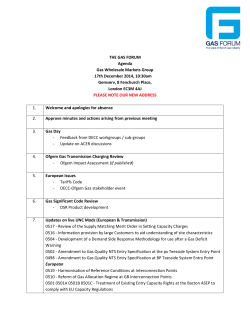
AN APPROACH FOR OVERLAPPING CELL SEGMENTATION IN
AN APPROACH FOR OVERLAPPING CELL SEGMENTATION IN MULTI-LAYER
CERVICAL CELL VOLUMES
Hady Ahmady Phoulady, Dmitry B. Goldgof, Lawrence O. Hall, Peter R. Mouton
University of South Florida, Tampa, USA
hady@mail.usf.edu, {goldgof,hall}@cse.usf.edu, pmouton@health.usf.edu
ABSTRACT
We propose a new method for detecting and segmenting overlapping cells in Pap smear images of multi-layer cervical cell
volumes. This is a critical step in automating the analysis of
cervical cells. This method first finds the nuclei inside the
image using an iterative thresholding approach, then segment
the location of overlapping cells, called cell clumps. The provided images from different focal are then used to segment
the cytoplasm corresponding to each nucleus. The algorithm
is evaluated using the dataset provided in the second overlapping cervical cytology image segmentation challenge at ISBI
2015. The results are presented based on two-fold cross validation on the training data which is provided with ground
truth.
1. METHODS
The segmentation of overlapping cervical cells in each image
is done in three steps: nuclei detection, cell clump segmentation and segmentation of individual cell’s cytoplasm inside
each cell clump.
For each multi-layer cell volume, an image obtained by a
one-pass extended depth of field (EDF) algorithm [1] is also
provided. The first two steps are performed on the provided
EDF images and the last step is done using images of different
depths. These steps are discussed in the following.
1.1. Nuclei Detection
Nuclei detection is done by processing the corresponding
EDF image for each cervical cell volume (Fig. 1(a)). To do
that a two-dimensional low-pass noise-removal filtering [2]
is performed on the image. Then an iterative thresholding is
performed to find the darkest pixels (usually corresponded to
nuclei). Each found region can grow for a certain number of
times in thresholding steps. The new regions which appear
in each thresholding step, are bounded by other previously
grown regions. The final regions represent the nuclei (Fig.
1(b)).
1.2. Cell Clump Segmentation
The cell clumps including overlapping cells (or isolated cells)
are found as follows. A Gaussian mixture model with two
components is learned based on pixel intensities. The two
components will represent the foreground and background.
Subsequently, the value of the background component’s quantile function at 0.1 is used it as a threshold to binarize the
image. Several morphological operations then follow to separate nearby cell clumps and remove too small cell clumps
(Fig. 1(c)).
1.3. Cell’s Cytoplasms Segmentation
Each EDF image is accompanied by 20 images of different
focals. These images are used to segment the cytoplasm corresponding to each detected nucleus. If a cell clump has no
segmented nucleus, it is rejected. If it has only one nucleus,
then it is assigned as the cytoplasm of the nucleus. In case
of existence of more than one nucleus inside a cell clump, we
perform the following operation.
Each depth image is divided into square regions by a
grid (each square is 8x8 pixel in this study). For each grid
square, the standard deviation and average edge strength
based on the Sobel operator are computed and used as a
measure of sharpness. By a grid width of 8, each image
is divided to 128 × 128 grid squares. For each EDF image, denote the depth images by I1 through I20 . Also let
i,j
Gi,j
k and Sk denote the average edge gradient and standard deviation of pixels intensities inside the (i, j)−th grid
square of the k-th depth image respectively. We then put
i,j
Tki,j = Ski,j Gi,j
k . For each grid square (i, j), Tk values are
normalized to the interval [0, 1]. New values are denoted by
i,j
T k . Moreover, suppose there are N nuclei inside a specific cell clump and suppose n-th nucleus overlaps with grid
squares (in,1 , jn,1 ), (in,2 , jn,2 ), · · · , (in,sn , jn,sn ). For each
two grid squares (i, j) and (i0 , j 0 ) we define
v
u 20 uX i,j
0 0
i0 ,j 0 2
i ,j
Di,j = t
Tk − Tk
.
(1)
k=1
(a) Overlapped Cells
(b) Detected Nuclei
(c) Clump Boundary
(d) Cytoplasm Segmentation
Fig. 1. A sample of overlapped cells segmentation inside a cell clump.
α, β
12, 2.8
14, 1.8
Dataset
Train on first four images
Test on second four images
Train on second four images
Test on first four images
DC
0.853 ± 0.079
0.844 ± 0.071
0.850 ± 0.069
0.847 ± 0.078
FNo
0.326 ± 0.196
0.183 ± 0.064
0.197 ± 0.021
0.236 ± 0.092
TPp
0.934 ± 0.076
0.945 ± 0.076
0.879 ± 0.117
0.859 ± 0.117
FPp
0.002 ± 0.002
0.003 ± 0.002
0.002 ± 0.001
0.001 ± 0.001
Table 1. Results over “good” cell segmentations
Finally, for each nucleus inside the cell clump, e.g. n-th nucleus, and each grid square (i, j), we compute
i,j 2
sn
2
2
X
D
+
(i
−
i)
+
(j
−
j)
s
s
i ,j
, (2)
exp − s s
Fni,j =
2
2α
s=1
which measures how much the grid squares (is , js ) and (i, j)
are in focus in different depth images relatively and how close
they are to each other.
For each cell clump, the corresponding Fni,j is computed
for all grid squares which are overlapped with it. After that,
for each nucleus, n, inside the cell clump, we calculate
Bni,j = (N + β)Fni,j −
N
X
Fti,j .
on each fold and test it on the other fold. The result is
presented in terms of Dice Coefficient, False Negative (cell
level), True Positive (pixel level) and False Positive (pixel
level). Due to time constraint, the values of parameters are
selected based on highest DC achieved amongst only six different values of α and four different values of β. The results
are summarized in Table 1. The final values of α and β used
to generate the segmentations of provided test images are 14
and 2.8.
The method can be improved further to include the edge
information for cytoplasm segmentation. Moreover, the False
Negative rate can be decreased potentially by using ground
truth provided for nuclei in each image and improving the
nuclei detection part of the method.
(3)
t=1
Finally we classify grid square (i, j) as a part of the cytoplasm
of cell with nucleus n if Bni,j > 0. Morphological operations
are then performed to smooth the boundary and bound the
cytoplasm inside the cell clump (Fig. 1(d)).
2. RESULTS AND CONCLUSION
Each image provided in the “The Second Overlapping Cervical Cytology Image Segmentation Challenge” (ISBI 2015)
are 1024x1024 pixels. Eight multi-layer cervical cell volumes
are provided for training, which include the ground truth, and
eight others are used for testing the algorithms.
Because the test data has no provided ground truth, we
divide the training data to two parts and perform a two-fold
cross validation. We learn the two parameters α and β based
3. REFERENCES
[1] Andrew P. Bradley and Pascal C. Bamford, “A onepass extended depth of field algorithm based on the overcomplete discrete wavelet transform,” Image and Vision
Computing (IVCNZ’04), November 2004.
[2] Jae S. Lim, Two-dimensional Signal and Image Processing, Prentice-Hall, Inc., Upper Saddle River, NJ, USA,
1990.
© Copyright 2025











